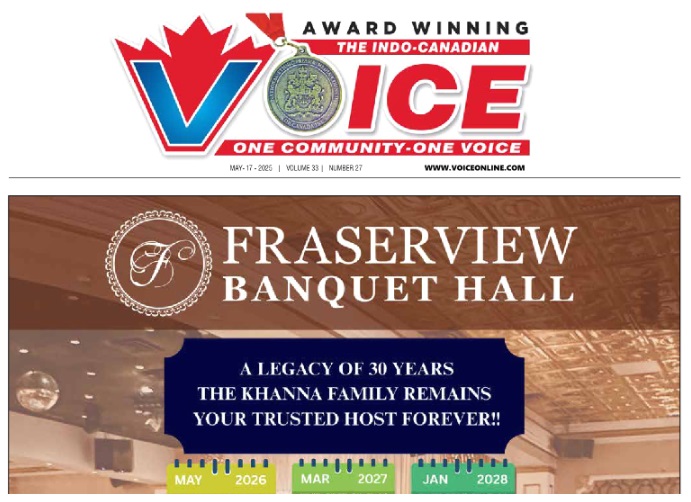THERE was no attempt for several years to challenge the continuous journey rule put into effect after the success of the SS Monteagle case. Shipping companies like the CPR eliminated direct passages and through ticketing from India, though a handful of lucky migrants were able to obtain through ticketing. When a new Immigration Act was passed by Parliament in 1910, the government re-enacted the same continuous journey restriction and the $200 cash requirement for Asiatic migrants.
During that time the west coast of North America became a gathering place for various Indian nationalists, whose goal was Indian independence from British colonial rule. Their presence raised concern in Delhi. It also attracted a former Anglo-Indian police officer from Kolkata, William Hopkinson, who came to Vancouver in 1908. He would become a central player in the events of 1914 involving the Komagata Maru. In early 1909 he became an immigration officer. He also became a Dominion Police officer and he send regular intelligence reports to London and Delhi on the activities of Indian nationalists.
Hopkinson created a network of informants in Canada and the United States to keep tabs on the political activists. Efforts were made to discourage their activities. In early 1910 a Gujarati cotton merchant, Husain Rahim, came to Vancouver. When told of the continuous journey rule, he convinced the immigration officials to let him enter as a tourist. He stayed on. When he made himself known to officials later that year, he was ordered deported. He also attracted Hopkinson’s attention, when he was found in possession of a list of activists.
Rahim twice challenged the deportation order. In early 1911 the BC Supreme Court found that the government had no authority to order his deportation because he had changed his mind to stay in Canada. A second deportation order in late 1911 was also defeated. The court held that new rules to remove tourists who remained in Canada under the 1910 Immigration Act did not apply to Rahim as he entered prior to their coming into effect. The court also suggested that the continuous journey and $200 requirement rules were invalid. The latter comments received no public notice. It was two years before the court’s comments were given life.
In October, 1913, the SS Panama Maru docked in Victoria. Among the passengers were 56 Indian nationals, the largest number of Indian nationals attempting to enter Canada since 1908. Some were allowed to re-enter as returning residents. The rest were ordered deported under the continuous journey regulation. The group challenged the orders. On November 24, 2013, Justice Hunter ruled the restrictive orders invalid on the ground that they were not written according to the terms used in the Immigration Act, as decided in the Rahim case.
Following the victory, residents wrote to family and friends to come to Canada while the door was open. The Borden government quickly shut the door, passing new rules in early January, 1914, that complied with the court’s judgment.
However, a wealthy Sikh contractor from Malaya, Gurdit Singh Sirhali, took up the challenge of testing the restrictive rules. During spring 1914 he chartered a Japanese-owned ship, the Komagata Maru, to carry several hundred Indian passengers to Canada. The ship set sail from Hong Kong in early April, travelling to China and Japan, collecting more passengers, before making its way across the Pacific to arrive in Vancouver on May 23.
The ship remained anchored in Burrrard Inlet for almost two months; its passengers kept as virtual prisoners on the ship. Of the 375 passengers on board, about 20 were allowed off as returning residents. The rest were denied entry under the continuous journey rule, the $200 requirement rule and under a new rule passed on March 31 that prohibited the landing of skilled or unskilled labourers.
After debate and negotiation, it was agreed to have the deportation order of one passenger, Munshi Singh Gulpur, put forward as a test case. A habeas corpus application was summarily rejected in order to allow for an appeal to the BC Court of Appeal. The appeal was heard in Victoria in late June. The court rendered its judgement on July 6, upholding the deportation. The court found 1914 rules validly enacted under the Immigration Act. It upheld Parliament’s power to enact immigration rules that could prohibit British subjects, including those born in the United Kingdom, and to discriminate between different classes of subjects.
Subsequent events quickly overshadowed the Komagata Maru. Within a month Canada was at war. The continuous journey rule continued to remain in effect for more than 30 years. Limited migration from South Asia was allowed in the early 1950s. Restrictions based on nationality were eliminated in 1962. Immigration law is inherently discriminatory as it sets rules for the selection of immigrants and workers. In the next part, I will look at the events of a century ago and show what has changed and what policies have not changed.
BY WILLIAM MACINTOSH
William Macintosh started practising as an immigration lawyer in 1984. You can reach him for advice or help on any immigration or citizenship matter at 778-714-8787 or by email at [email protected]

















